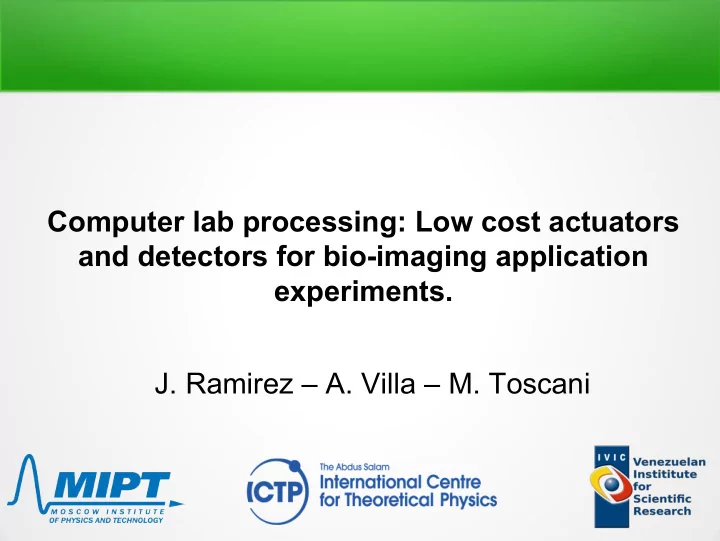

Computer lab processing: Low cost actuators and detectors for bio-imaging application experiments. J. Ramirez – A. Villa – M. Toscani
Introduction What Is this presentation about: ● Provide a general overview of detectors, actuators and it’s importance applied to Bio-Imaging. ● Emphasizing on reliability, high sensitivity, low noise and low cost.
Introduction In the broadest definition, a sensor is to detect events or changes in its environment, it converts real world data (Analog) into data that a computer can understand.
Introduction What is an Actuator? ● It is a device capable of performing a movement or a mechanical action over another hardware.
Introduction Detectors Actuators Sensors
Bio Imaging Acquire Process Visualize Structural Functional Living objects or systems
Bio Imaging: Reproducibility Tissue Time Lapse MRI Isolated Cell Macro and Calcium Micro Fluorescence Gallium Isolated organ Phosphorescence Stimulated Field Stimulation Emission Ultrasound High Durability Molecular Bio Lumniscence Thermography Photo Acoustic
The problem What do I Need to make Low cost Bio Imaging? High High Sensitivity Durability High High Low Noise Reproducibility Speed
The problem What do I Need? Add functions or Build from modify Scratch my existent setup
The problem What do I Need? ● Synchronizations? ● Real time? ● High speed? ● Single detector? ● Small array? ● Camera?
The problem Image means optics? YES!!! ● Manufacturers and their “secrets”. ● Not easily adaptable nor modifiable. ● Firmware is closed source. ● Image quality or speed of acquisition? ● Apply KISS (Keep It Simple Straight).
The problem What is KISS principle? ● Design principle noted by the U.S. Navy in 1960. ● States that most systems work best if they are kept simple rather than made complicated. ● Simplicity should be a key goal in design and unnecessary complexity should be avoided.
The solution: Sensor & Detectors PhotoMultiplier Complex Expensive Best In c Tube Charged Coupled Simple Expensive Best in c Devices CMOS Image Simple Low Cost Noisy Sensor Photodiode Array Moderat Low Cost A/D Proc Photocell Array Moderat Low Cost A/D Proc
The Solution: Sensor & Detectors Single big area Moderat Multiprice A/D Proc Photo Diode Single big area Simple Multiprice Best IC Photocell IR Pyrometers Various Low Cost Noisy Fiber Optics Moderat Low Cost Detector
The solution: Actuators Our Worst Enemy: Vibration ● High Tech ● Damping Control ● High Tech Actuator
The Solution: Actuators DC Motor Based Easy Low Cost Elec. Noi Stepper Based Easy Low Cost Vibration Piezo Motors Various Expensive Best IC Linear Non-Movin Moderat Expensive V. Good
The Solution: Damping ● Passive damping: Affordable and effective, but has easy to reach limits. ●Active damping: Difficult to implement and expensive. Highly durable and trustable.
The Solution: Control Methods Analysis of Implementation control Test of Method needs Mechanical Damping Vibration? Damping by software Are spatial parameters No adequate? Ye Use the system s
The Solution: Control Methods DC H bridge Easy Low Cost Elec. Noi Stepper Half H Easy Multiprice Vibration AC Variator Various Expensive Best IC Linear Non-Movin Moderat Expensive V. Good
Programmable logic controller Allows us to: ● Data acquisition. ● Motor Control. ● Displacement sensing. ● Safety measures. ● In one device.
Low cost signaling Easy built-in hardware: ● Pulse Width Modulation. ● TImers. ● A/D converters. ● Some has D/A. ● All integrated in the microcontroller.
Data Acquisition Microcontrollers: ● Can do DAQ. ● Limited Speeds. ● Only recommended for slow signals or phenomena. ● Is advised to use a separate DAQ system.
Synchronization Microcontrollers: ● Camera synchronization is possible, with an input or output from the camera. ● Field stimulation needs special isolation.
Displacement sensors Allows us to: ● Have feedback of the movement of motors and actuators. ● Implement a coordinate system. ● Know or determine the position of an element.
Disadvantages ● Sensitivity of movement and detection can be easily underestimated. ● Problems in firmware and control methods are the predominant malfunctions, and take long time to solve by inexperienced programmers. ● To a successful implementation, is desirable to have some experience in instrumentation.
Conclusions Detectors Actuators Learning Opportunities Support and collaboration Better, faster from research by communities less money.
Useful Resources ●Sensor manufacturers: Hammamatsu, Kyocera, Analog Devices, Sharp. ●Cameras: Cohu 4900, RasPiCam, Elphel cameras, Playstation Eye, Photonis ● Motors: Buehler, Seiko, Mabuchi. ● Gearboxes: 4D robotics, Tamiya. ●Encoder Sensors: Agilent, Hohner. ●Microcontrollers: Microchip, Atmel.
Thank you for your attention. Questions javierramirezbenavides@gmail.com jaramirez@ivic.gob.ve “The reasonable man adapts himself to the world; the unreasonable one persists in trying to adapt the world to himself. Therefore all progress depends on the unreasonable man.” -George Bernard Shaw.
Recommend
More recommend